Inorganic Selenium Transformation into Organic Selenium by Monascus purpureus
Abstract
:1. Introduction
2. Materials and Methods
2.1. Strains and Materials
2.2. M. purpureus Activation
2.3. Se-Rich Culture and Growth Monitoring of M. purpureus
2.4. Comparison of Se-Rich Variations in Mycelium and Spores
2.5. Impact of Culture Conditions on M. purpureus Se-Enrichment
- (1)
- Effect of pH on Se-enrichment of M. purpureus
- (2)
- Effect of temperature on Se-enrichment of M. purpureus
- (3)
- Effect of rotational speed on Se-enrichment of M. purpureus
2.6. Design of the Response Surface (RSM) Experiment
2.7. Selenium Conversion Rate of Se-Rich M. purpureus
2.8. Effects of Sodium Selenite on M. purpureus Physiological Activity
2.9. Characteristics of the Second-Generation Strains of M. purpureus after Se-Enriched Culture
2.10. Data Processing
3. Results and Discussion
3.1. Subsection Se-Rich Growth and Metabolism of M. purpureus
3.2. Difference in Selenium Enrichment of M. purpureus Hyphae and Spores
3.3. Effect of Culture Conditions on Selenium Enrichment of M. purpureus
3.3.1. Effect of Nutrients on Selenium Enrichment of M. purpureus
3.3.2. Effect of Culture Temperature on Selenium Enrichment of M. purpureus
3.3.3. Effect of Oscillation Frequency on Selenium Enrichment of M. purpureus
3.4. Response Surface (RSM) Test
3.5. Physiological Activity of Se-Rich M. purpureus
3.5.1. Selenium Conversion Rate of Se-Rich M. purpureus
3.5.2. Se-Rich M. purpureus Monacoline K Output
3.6. Biological Activity of Se-Rich Monascus purpureus
4. Conclusions
Author Contributions
Funding
Data Availability Statement
Acknowledgments
Conflicts of Interest
References
- Uchida, D.; Takaki, A.; Adachi, T.; Okada, H. Beneficial and Paradoxical Roles of Anti-Oxidative Nutritional Support for Non-Alcoholic Fatty Liver Disease. Nutrients 2018, 10, 977. [Google Scholar] [CrossRef]
- Shi, L.; Ren, Y.; Zhang, C.; Yue, W.; Lei, F. Effects of maternal dietary selenium (Se-enriched yeast) on growth performance, antioxidant status and haemato-biochemical parameters of their male kids in Taihang Black Goats. Anim. Feed. Sci. Technol. 2017, 231, 67–75. [Google Scholar] [CrossRef]
- Zhang, Y.; Zhang, J.; Bao, J.; Tang, C.; Zhang, Z. Selenium deficiency induced necroptosis, Th1/Th2 imbalance, and inflammatory responses in swine ileum. J. Cell Physiol. 2021, 236, 222–234. [Google Scholar] [CrossRef]
- Zhang, R.Q.; Zhang, D.D.; Zhang, D.; Yang, X.L.; Li, Q.; Wang, C.; Yang, X.N.; Xiong, Y.M. Crosstalk between CpG Methylation and Polymorphisms (CpG-SNPs) in the Promotor Region of DIO2 in Kashin-Beck Disease. Chin. Med. Sci. J. 2022, 37, 52–59. [Google Scholar] [CrossRef]
- Hirsch, S.; Skripuletz, T.; Seeliger, T.; Witte, T.; Thiele, T. Selenium deficiency is associated with polyneuropathy in primary Sjögren’s syndrome. Clin. Nutr. ESPEN 2022, 50, 212–217. [Google Scholar] [CrossRef]
- Zeng, H.; Qin, L.; Liu, X.; Miao, S. Increases of Lipophilic Antioxidants and Anticancer Activity of Coix Seed Fermented by Monascus purpureus. Foods 2021, 10, 566. [Google Scholar] [CrossRef]
- Wang, N.; Wu, Y.; Jia, G.; Wang, C.; Xiao, D.; Goff, H.D.; Guo, Q. Structural characterization and immunomodulatory activity of mycelium polysaccharide from liquid fermentation of Monascus purpureus (Hong Qu). Carbohydr. Polym. 2021, 262, 117945. [Google Scholar] [CrossRef]
- Almeida, A.B.d.; Santos, N.H.; Lima, T.M.d.; Santana, R.V.; Oliveira Filho, J.G.d.; Peres, D.S.; Egea, M.B. Pigment bioproduction by Monascus purpureus using corn bran, a byproduct of the corn industry. Biocatal. Agric. Biotechnol. 2021, 32, 101931. [Google Scholar] [CrossRef]
- Liu, J.; Wu, J.; Cai, X.; Zhang, S.; Liang, Y.; Lin, Q. Regulation of secondary metabolite biosynthesis in Monascus purpureus via cofactor metabolic engineering strategies. Food Microbiol. 2021, 95, 103689. [Google Scholar] [CrossRef]
- Sun, Y.; Shi, Y.; Jia, H.; Ding, H.; Yue, T.; Yuan, Y. Biosynthesis of selenium nanoparticles of Monascus purpureus and their inhibition to Alicyclobacillus acidoterrestris. Food Control 2021, 130, 108366. [Google Scholar] [CrossRef]
- Dobrzyńska, M.; Drzymała-Czyż, S.; Woźniak, D.; Drzymała, S.; Przysławski, J. Natural Sources of Selenium as Functional Food Products for Chemoprevention. Foods 2023, 12, 1247. [Google Scholar] [CrossRef] [PubMed]
- Wang, P.; Li, Y.; Yu, R.; Huang, D.; Chen, S.; Zhu, S. Effects of Different Drying Methods on the Selenium Bioaccessibility and Antioxidant Activity of Cardamine violifolia. Foods 2023, 12, 758. [Google Scholar] [CrossRef] [PubMed]
- Xu, X.; Pan, Y.; Liu, X.; Han, Z.; Chen, S. Constructing Selenium Nanoparticles with Enhanced Storage Stability and Antioxidant Activities via Conformational Transition of Curdlan. Foods 2023, 12, 563. [Google Scholar] [CrossRef]
- Zhou, J.; Liu, Y.; Hu, Y.; Zhang, D.; Xu, W.; Chen, L.; He, J.; Cheng, S.; Cai, J. Selenium Nanoparticles Synergistically Stabilized by Starch Microgel and EGCG: Synthesis, Characterization, and Bioactivity. Foods 2023, 12, 13. [Google Scholar] [CrossRef]
- Wang, Y.-Z.; Ju, X.-L.; Zhou, Y.-G. The variability of citrinin production in Monascus type cultures. Food Microbiol. 2005, 22, 145–148. [Google Scholar] [CrossRef]
- Hu, M.; Zhang, X.; Wang, Z. Releasing intracellular product to prepare whole cell biocatalyst for biosynthesis of Monascus pigments in water–edible oil two-phase system. Bioprocess Biosyst. Eng. 2016, 39, 1785–1791. [Google Scholar] [CrossRef] [PubMed]
- Agboyibor, C.; Kong, W.-B.; Chen, D.; Zhang, A.-M.; Niu, S.-Q. Monascus pigments production, composition, bioactivity and its application: A review. Biocatal. Agric. Biotechnol. 2018, 16, 433–447. [Google Scholar] [CrossRef]
- Silbir, S.; Goksungur, Y. Natural Red Pigment Production by Monascus purpureus in Submerged Fermentation Systems Using a Food Industry Waste: Brewer’s Spent Grain. Foods 2019, 8, 161. [Google Scholar] [CrossRef]
- Wong, H.-C.; Koehler, P.E. Production and Isolation of an Antibiotic from Monascus purpureus and its Relationship to Pigment Production. J. Food Sci. 1981, 46, 589–592. [Google Scholar] [CrossRef]
- Khoshru, B.; Khoshmanzar, E.; Asgari Lajayer, B.; Ghorbanpour, M. Chapter 29—Soil moisture–mediated changes in microorganism biomass and bioavailability of nutrients in paddy soil. In Plant Stress Mitigators; Ghorbanpour, M., Adnan Shahid, M., Eds.; Academic Press: New York, NY, USA, 2023; pp. 479–494. [Google Scholar]
- Vu, D.L.; Saurav, K.; Mylenko, M.; Ranglová, K.; Kuta, J.; Ewe, D.; Masojídek, J.; Hrouzek, P. In vitro bioaccessibility of selenoamino acids from selenium (Se)-enriched Chlorella vulgaris biomass in comparison to selenized yeast; a Se-enriched food supplement; and Se-rich foods. Food Chem. 2019, 279, 12–19. [Google Scholar] [CrossRef]
- Oliveira, H.; Muniz, J.A.; Bandarra, N.M.; Castanheira, I.; Coelho, I.R.; Delgado, I.; Gonçalves, S.; Lourenço, H.M.; Motta, C.; Duarte, M.P.; et al. Effects of Industrial Boiling on the Nutritional Profile of Common Octopus (Octopus vulgaris). Foods 2019, 8, 411. [Google Scholar] [CrossRef] [PubMed]
- Wang, T.; Zhao, Y.; Wang, M.; Zhou, J.; Yang, M.; Na, S. Organic selenium compounds determination in the complex matrix by the 1H-77Se HMBC method. Microchem. J. 2022, 183, 108032. [Google Scholar] [CrossRef]
- Zwierzchowski, G.; Ametaj, B.N. Mineral Elements in the Raw Milk of Several Dairy Farms in the Province of Alberta. Foods 2019, 8, 345. [Google Scholar] [CrossRef] [PubMed]
- Liu, H.; Yu, Q.; Fang, C.; Chen, S.; Tang, X.; Ajuwon, K.M.; Fang, R. Effect of Selenium Source and Level on Performance, Egg Quality, Egg Selenium Content, and Serum Biochemical Parameters in Laying Hens. Foods 2020, 9, 68. [Google Scholar] [CrossRef] [PubMed]
- Vacchina, V.; Foix, D.; Menta, M.; Martinez, H.; Séby, F. Optimization of elemental selenium (Se(0)) determination in yeasts by anion-exchange HPLC-ICP-MS. Anal. Bioanal. Chem. 2021, 413, 1809–1816. [Google Scholar] [CrossRef]
- Liu, X.; Sun, A.; Li, Q.; Du, Y.; Zhao, T. A systematic study of the production of Monacolin K by solid state fermentation of Monascus ruber. AMB Express 2022, 12, 29. [Google Scholar] [CrossRef]
- Embate, M.V.G.; Calayugan, M.I.C.; Gentallan, R.P.; Sta Cruz, P.C.; Hernandez, J.E.; Borromeo, T.H. Genetic diversity of selected pigmented traditional rice (Oryza sativa L.) varieties from Mindanao, Philippines using agromorphological traits and simple sequence repeats markers. J. Crop Sci. Biotechnol. 2021, 24, 259–277. [Google Scholar] [CrossRef]
- Bhat, F.M.; Sommano, S.R.; Riar, C.S.; Seesuriyachan, P.; Chaiyaso, T.; Prom-u-Thai, C. Status of Bioactive Compounds from Bran of Pigmented Traditional Rice Varieties and Their Scope in Production of Medicinal Food with Nutraceutical Importance. Agronomy 2020, 10, 1817. [Google Scholar] [CrossRef]
- Chen, X.; Chen, M.; Wu, X.; Li, X. Cost-effective process for the production of Monascus pigments using potato pomace as carbon source by fed-batch submerged fermentation. Food Sci. Nutr. 2021, 9, 5415–5427. [Google Scholar] [CrossRef]
- Juan, M.-Y.; Wu, C.-H.; Chou, C.-C. Fermentation with Bacillus spp. as a bioprocess to enhance anthocyanin content, the angiotensin converting enzyme inhibitory effect, and the reducing activity of black soybeans. Food Microbiol. 2010, 27, 918–923. [Google Scholar] [CrossRef]
- Barbulescu, I.; Ferdes, M.; Carmen, B.; Rodica, A.; Teodorescu, R. Improving wine-making products with selenium and total polyphenols. Rom. Biotechnol. Lett. 2012, 17, 7646–7655. [Google Scholar]
- Zhu, Z.; Bassey, A.P.; Huang, T.; Zhang, Y.; Ali Khan, I.; Huang, M. The formation, germination, and cold plasma inactivation of bacterial spore. Food Chem. Adv. 2022, 1, 100056. [Google Scholar] [CrossRef]
- Abdel Rahim, S.; Al-Zoubi, N.; Khader, H.; Alwaraydat, R.; Al-Akayleh, F. Ethanol-induced dose dumping from sodium alginate matrix tablets: Investigation of the effects of medium viscosity and pH. Int. J. Pharm. 2023, 632, 122568. [Google Scholar] [CrossRef] [PubMed]
- Huang, C.-F.; Shen, S.-M.; Chen, W.-T.; Chen, C.-C. The effects of mutation and temperature variation on monacolin K production by Monascus sp. and relative statistical parameter analysis of monacolin K production. Phytochem. Lett. 2019, 32, 143–150. [Google Scholar] [CrossRef]
- Aro, A.; Alfthan, G.; Varo, P. Effects of supplementation of fertilizers on human selenium status in Finland. Analyst 1995, 120, 841–843. [Google Scholar] [CrossRef] [PubMed]
- Bañuelos, G.S.; Centofanti, T.; Zambrano, M.C.; Vang, K.; Lone, T.A. Salsola soda as selenium biofortification crop under high saline and boron growing conditions. Front. Plant Sci. 2022, 13, 996502. [Google Scholar] [CrossRef]
- Zhang, C.; Chen, M.; Zang, Y.; Wang, H.; Wei, X.; Zhu, Q.; Yang, X.; Sun, B.; Wang, C. Effect of arginine supplementation on Monacolin K yield of Monascus purpureus. J. Food Compos. Anal. 2022, 106, 104252. [Google Scholar] [CrossRef]
- Liang, Z.; Lin, X.; He, Z.; Su, H.; Li, W.; Ren, X. Amino acid and microbial community dynamics during the fermentation of Hong Qu glutinous rice wine. Food Microbiol. 2020, 90, 103467. [Google Scholar] [CrossRef]
- Zhang, L.; Li, D.; Gao, P. Expulsion of selenium/protein nanoparticles through vesicle-like structures by Saccharomyces cerevisiae under microaerophilic environment. World J. Microbiol. Biotechnol. 2012, 28, 3381–3386. [Google Scholar] [CrossRef]
- Snyder, A.B.; Churey, J.J.; Worobo, R.W. Association of fungal genera from spoiled processed foods with physicochemical food properties and processing conditions. Food Microbiol. 2019, 83, 211–218. [Google Scholar] [CrossRef]
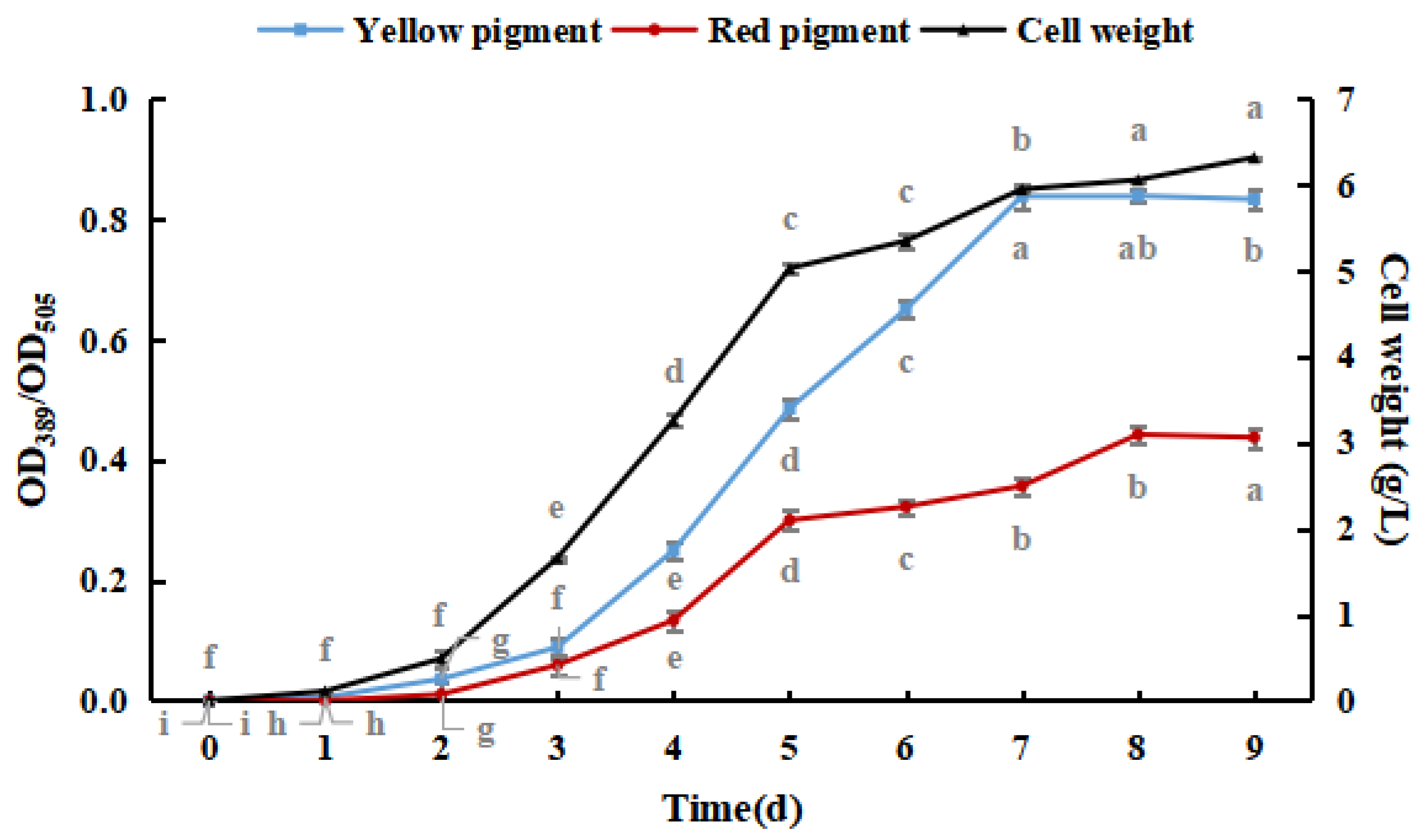
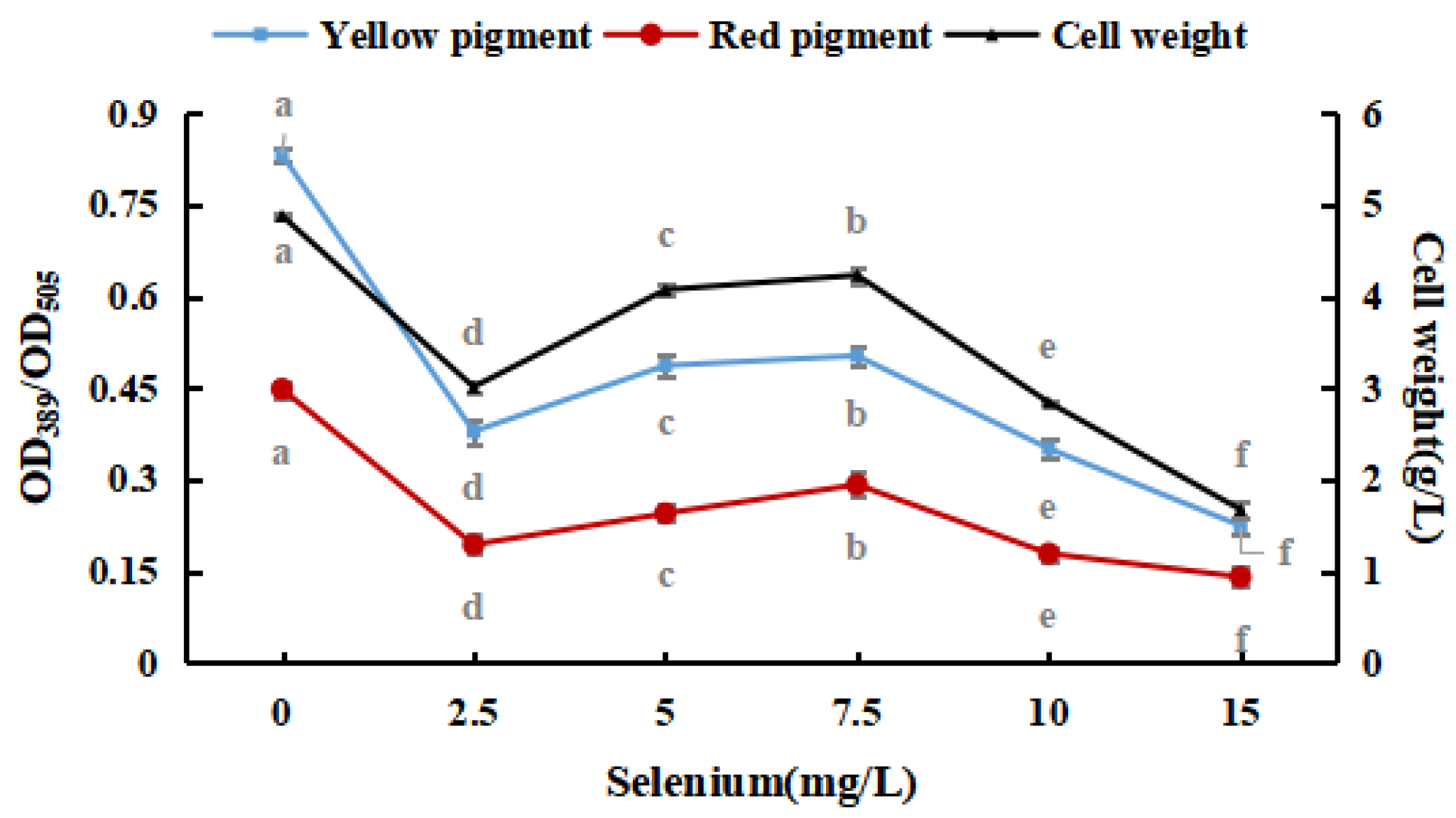

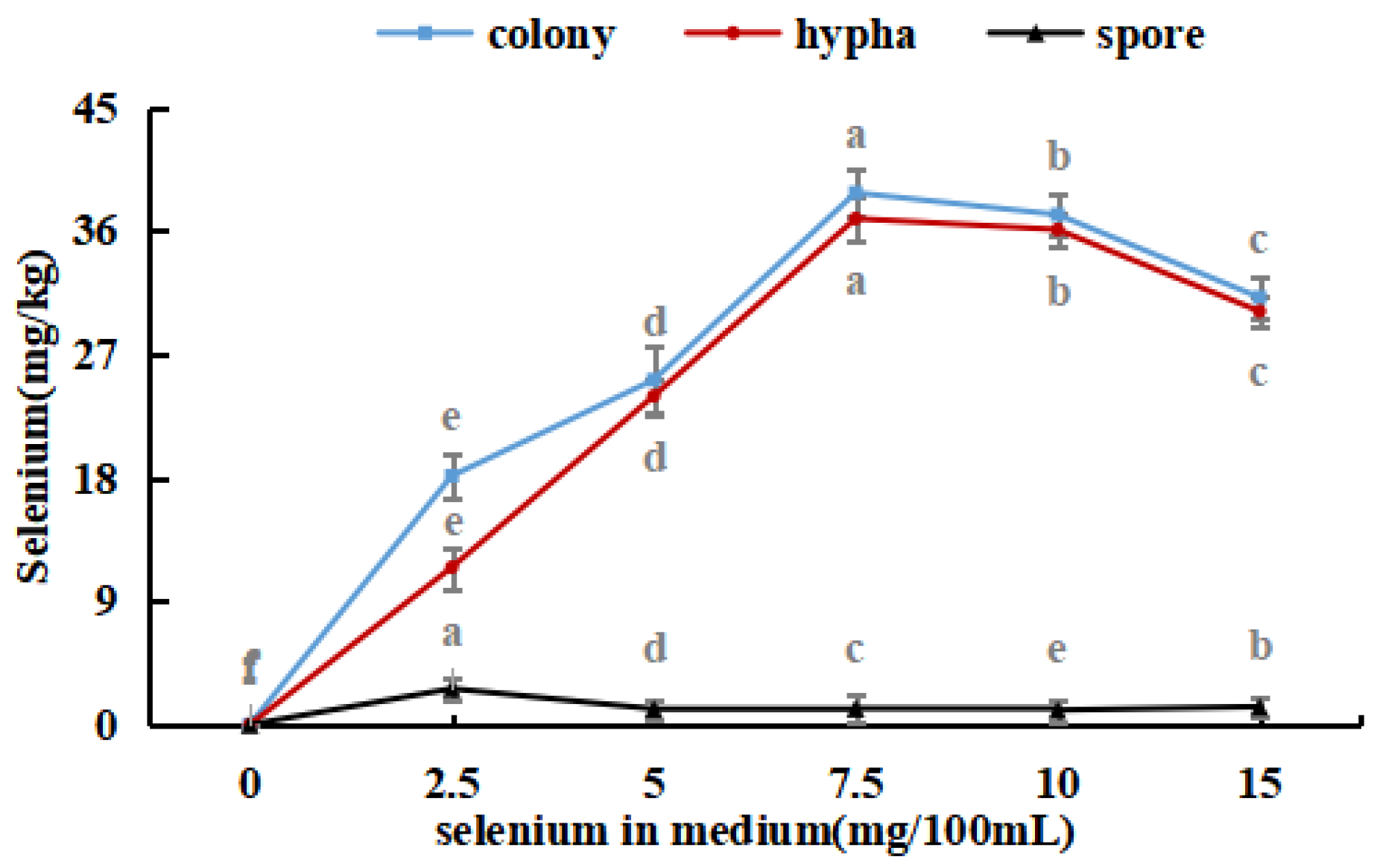




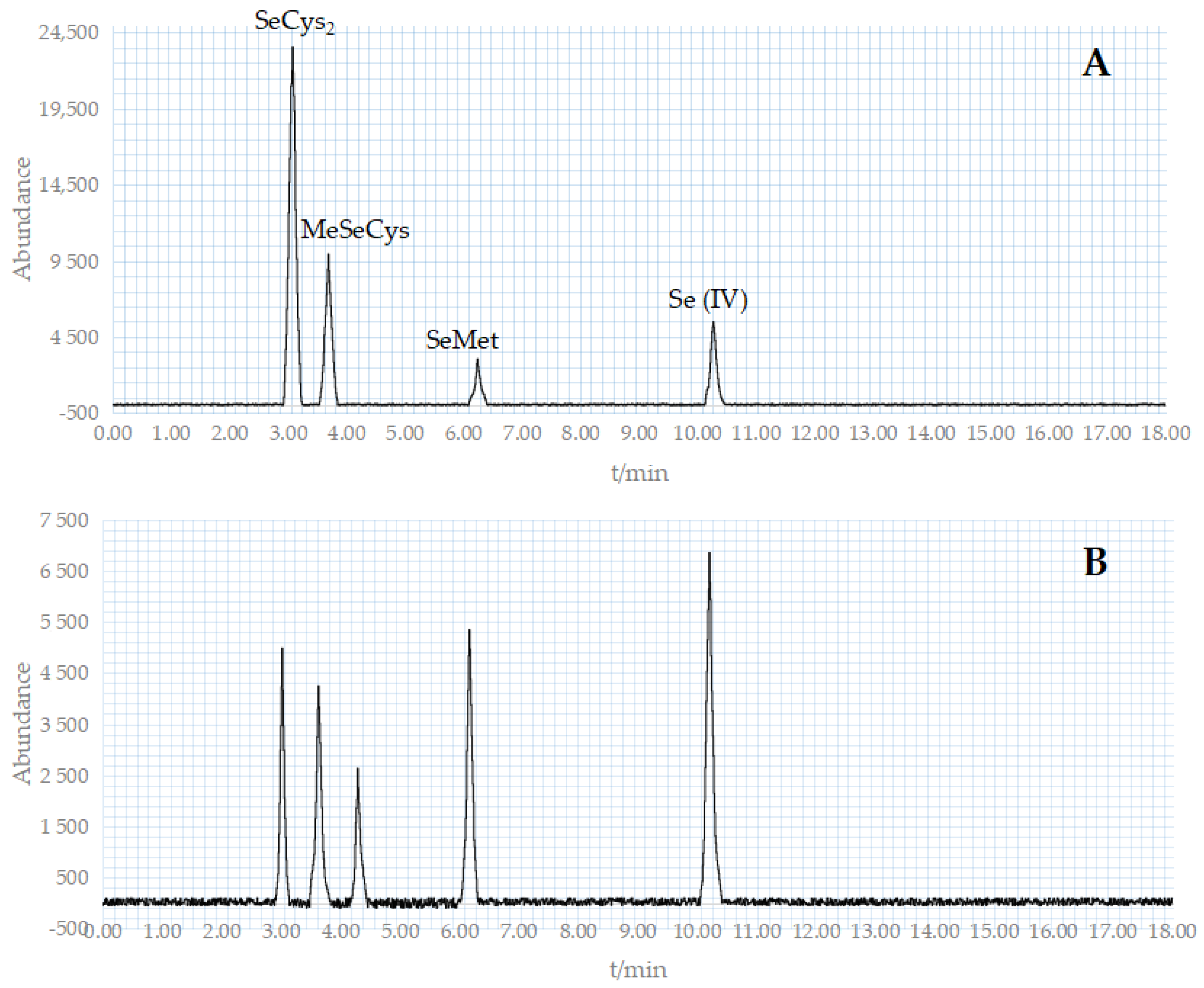
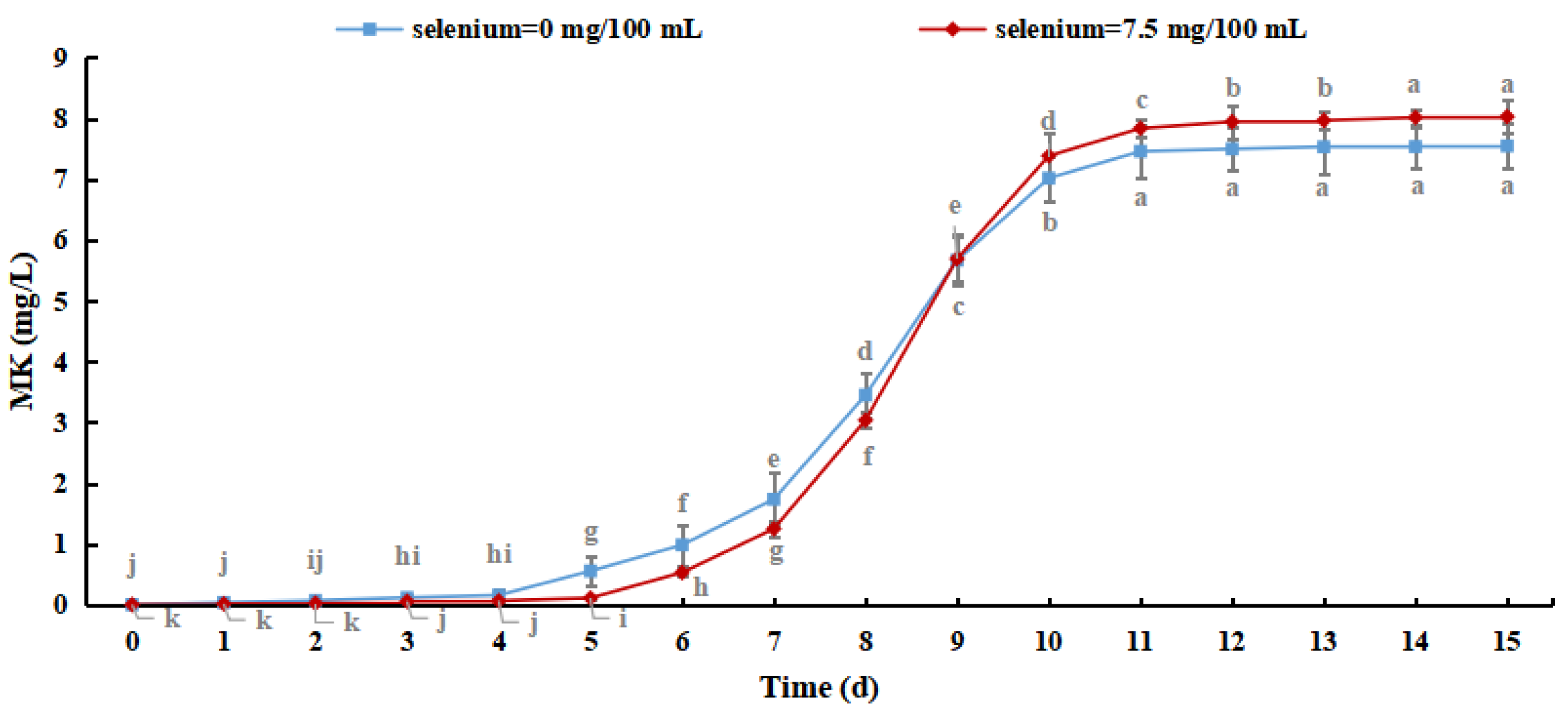
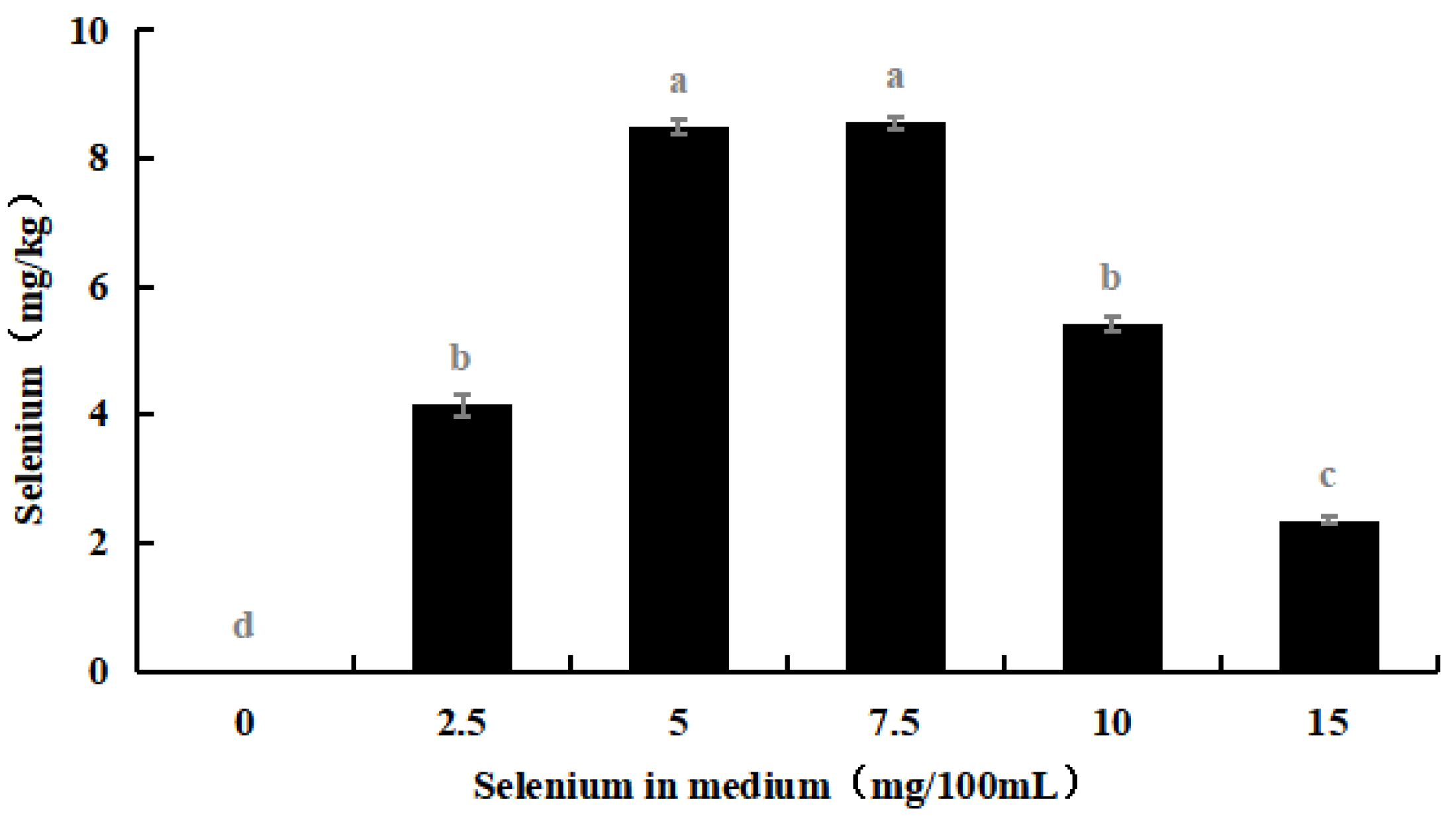
| Horizontal | Factor | ||
|---|---|---|---|
| A pH | B Rotate Speed (r/min) | C Temperature (°C) | |
| −1 | 6 | 130 | 27 |
| 0 | 7 | 180 | 30 |
| 1 | 8 | 230 | 33 |
| Source of Variation | Degree of Freedom | Square Sum | Mean Square | F | P | Statistical Significance |
|---|---|---|---|---|---|---|
| A-pH | 1 | 1.13 | 1.13 | 28,013.83 | <0.0001 | *** |
| B-Temperature | 1 | 0.00784 | 0.00784 | 195.23 | 0.867 | |
| C-speed | 1 | 2.94 | 2.94 | 73,150.72 | <0.0001 | *** |
| A^2 | 1 | 14.56 | 14.56 | 362,600 | <0.0001 | *** |
| B^2 | 1 | 0.36 | 0.36 | 8891.59 | <0.0001 | *** |
| C^2 | 1 | 11.74 | 11.74 | 292,400 | <0.0001 | *** |
| Residual | 7 | 0.000281 | 0.00004 | |||
| Misfit item | 9 | 27.95 | 3.11 | 77,337.39 | 0.5505 | |
| Sum | 16 | 27.95 |
| Selenium Addition (mg/100 mL) | 0 | 2.5 | 5 | 7.5 | 10 | 15 |
|---|---|---|---|---|---|---|
| Selenium conversion rate (%) | 0 | 22.93 ± 0.021 | 22.85 ± 0.014 | 22.20 ± 0.019 | 21.51 ± 0.020 | 21.11 ± 0.021 |
| Project | Graininess | Powder | |
|---|---|---|---|
| Moisture content/% | 5.14 ± 0.07 | 3.48 ± 0.64 | |
| Aflatoxin B1/(μg/kg) | 1.96 ± 0.14 | 1.66 ± 0.21 | |
| Color valence/(μ/g) | 3.64 × 103 | 3.81 × 103 | |
| Fineness 150 μm Pass rate/% | - | 97.64 ± 0.16 | |
| Total arsenic(As)/(mg/kg) | 0.16 ± 0.01 | 0.14 ± 0.01 | |
| Heavy metal(Pb)/(mg/kg) | 0.038 ± 0.004 | 0.038 ± 0.005 | |
| Microbiological indicators | Escherichia coli/(MPN/g) | 1.06 ± 0.02 | 1.05 ± 0.03 |
| Salmonella/(MPN/g) | - | - | |
| Shigella/(MPN/g) | - | - | |
| Staphylococcus aureus/(MPN/g) | - | - | |
Disclaimer/Publisher’s Note: The statements, opinions and data contained in all publications are solely those of the individual author(s) and contributor(s) and not of MDPI and/or the editor(s). MDPI and/or the editor(s) disclaim responsibility for any injury to people or property resulting from any ideas, methods, instructions or products referred to in the content. |
© 2023 by the authors. Licensee MDPI, Basel, Switzerland. This article is an open access article distributed under the terms and conditions of the Creative Commons Attribution (CC BY) license (https://creativecommons.org/licenses/by/4.0/).
Share and Cite
Sun, N.; Dang, H.; Zhang, Y.; Yang, M.; Zhang, W.; Zhao, Y.; Zhang, H.; Ji, H.; Zhang, B. Inorganic Selenium Transformation into Organic Selenium by Monascus purpureus. Foods 2023, 12, 3375. https://doi.org/10.3390/foods12183375
Sun N, Dang H, Zhang Y, Yang M, Zhang W, Zhao Y, Zhang H, Ji H, Zhang B. Inorganic Selenium Transformation into Organic Selenium by Monascus purpureus. Foods. 2023; 12(18):3375. https://doi.org/10.3390/foods12183375
Chicago/Turabian StyleSun, Nan, Hui Dang, Yuyao Zhang, Mengjie Yang, Wei Zhang, Yu Zhao, Haisheng Zhang, Hua Ji, and Baoshan Zhang. 2023. "Inorganic Selenium Transformation into Organic Selenium by Monascus purpureus" Foods 12, no. 18: 3375. https://doi.org/10.3390/foods12183375





